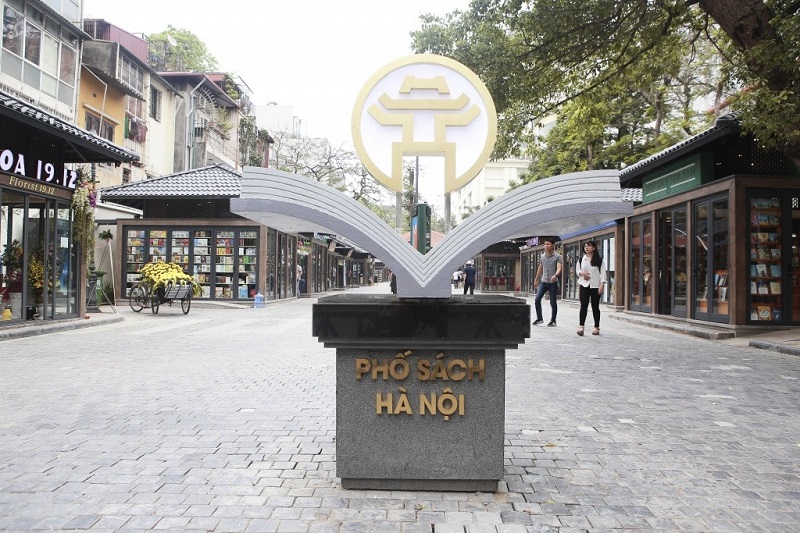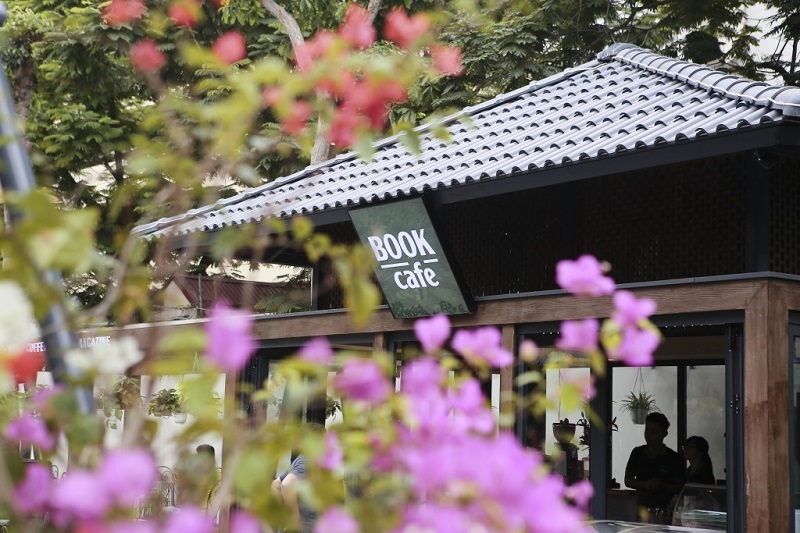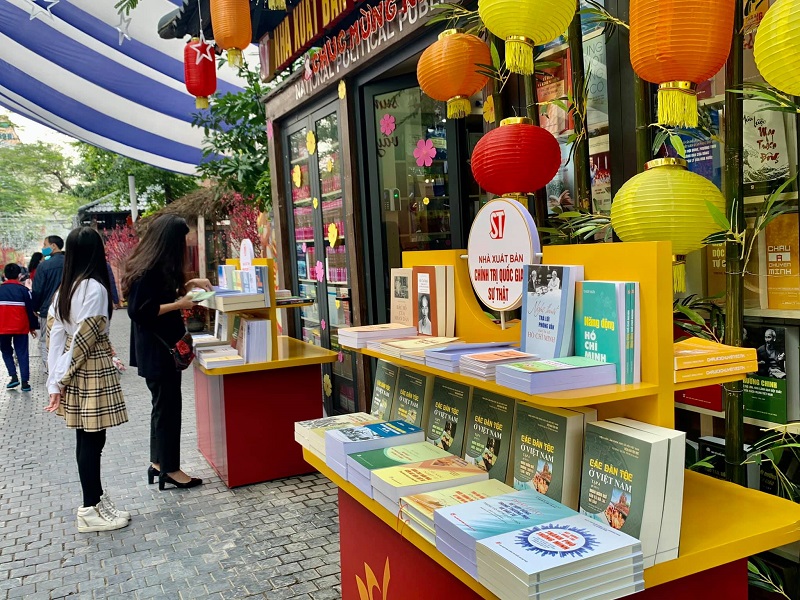Tales of Hanoi Streets: The ‘Underworld’ Market in Hanoi
The ‘knowledge street’ in Hanoi was once a witness to a painful history.
Hanoi’s first book street is currently crowded with visitors walking around and taking pictures. But few people know that the area used to be called the Underworld Market for its mass grave during the Anti-French Resistance War.
A mysterious corner of Hanoi
| Today Hanoi's Book Street. Photo: Donic Trinh |
Hanoi has a small street near the Supreme People’s Court and Mélia Hanoi Hotel, stretching only about 200 meters from Ly Thuong Kiet Street to Hai Ba Trung Street. Named "Hanoi Book Street", it was once a market known only by Hanoians born before the early 1980s, with a spooky name: the Underworld Market.
An Pham, 54, a resident who lives in Cua Nam Ward, Hoan Kiem District, told The Hanoi Times that when she was a child, she was filled with fear whenever she walked down Hai Ba Trung Street or Ly Thuong Kiet Street. The market was a desolate and mysterious place.
“The two ends of the street were barricaded, with only quietness and luxuriant trees inside. At that time, the Court already lay on one side of the street as it does now. As for the other side, I can only remember that, when the street became a market, there was an electromechanical factory with the daily clanking of stamping presses making the atmosphere less dreary,” she stated.
According to her, some mounds were said to be mass graves in the street, accompanied by a censer and a rood cross. The street is lined on both sides with tall trees that she often called ‘Musk’ trees, whose leaves had a strong scent.
In the quiet afternoons passing by, she sometimes saw a few flocks of blackbirds or starlings there, while at night, it was indeed the scene of a cemetery with only crickets chirping, which made any passer-by move faster instead of prowling around.
“Kids like us often played or threw dragon plums by the Court in the summer, yet we never dared to cross the fences and go deep inside the street, especially after being scared by adults saying that there were many ghosts around the place.
It was only when that street became a market called the ‘Underground’ Market that I got curious about the name and wanted to learn more about its background,” An added.
Painful history
| The old market has become a rendezvous for book lovers in Hanoi nowadays. Photo: Donic Trinh |
According to the senior citizens, during the French colonial period, the street was named after Rue Simoni, a French Resident-Superior of Tonkin between 1909 and 1912. In 1945, it was renamed ‘Le Chan’ Street, the name of a female general under the Trung sisters or Hai Ba Trung - the two national heroes rebelling against northern invaders (AD 43).
After the Japanese army arrived in Hanoi in 1942, the city government built an array of shelters along the street against the bombardment of American aircraft, then on the Allies’ side. An intermittent, temporary market began to form here as traders from Hang Da and Hang Be markets drifted to the neighborhood.
On the night of December 19, 1946, as President Ho Chi Minh made a public appeal for national resistance, thousands of soldiers and citizens in Hanoi rose against the French invaders, heroically falling in the battle. Their bodies in the French-occupied areas, mainly from Hang Bong and Cua Nam streets, were moved to Le Chan Street and thrown into the shelters, which became mass graves during the Anti-French Resistance War.
After the Capital’s Liberation Day (October 10th, 1954), the Vietnamese government renovated the grave with the following line on the gate: ‘Tomb of the people and soldiers who sacrificed themselves on National Resistance Day - December 19th, 1946’.
In 1981, the city excavated the area and transferred the remains to Bat Bat Cemetery in Ba Vi District. The old street was restored and renamed ‘19 Thang 12’ Street to commemorate the National Resistance event.
The ‘Underworld’ Market
The Cho am phu or Underground Market before 2008. File photo |
Sometime later, a spontaneous market emerged here, and in 1985, the city officially established ‘19 Thang 12 Market’. Because it is located on the former burial ground, people call it the Cho am phu or Underground Market.
The market offers a variety of goods, especially dog meat - which is believed to chase away evil spirits. The two rows of lush camphor trees planted at the beginning of the 20th century and a bodhi tree of unknown age remain.
Together with Hang Da Market or today’s Hang Da Plaza and Cua Nam Market, Underground Market is considered one of the major commercial centers in the region some decades ago where people could purchase almost all essentials for daily life, such as vegetables, pork, poultry, and even some electric devices or metalwork, according to An Pham.
“The market is divided into three sections that sell separate items. The first part of the market, which starts at Hai Ba Trung Street, specializes in selling all kinds of green vegetables. In the middle of the market, there are stalls selling pork and poultry. Meanwhile, the end of the market, which is on Ly Thuong Kiet Street, specializes in dry goods such as bamboo shoots, vermicelli, and some clothes,” An recalled.
Like many residents living around the area, the Underground Market is integral to An Pham’s memory.
Today’s ‘knowledge street’
| Hanoi's Book Street attracts a large number of visitors at the weekend. Photo: Hanoi Book Street |
At the end of 2008, 19 Thang 12 Market was included in a shopping mall construction project instead of being removed due to a fierce public reaction.
In the autumn of 2016, the Hanoi People's Committee approved the project of turning 19 Thang 12 Street into a pedestrianized book street, which has become one of the most beautiful in the capital.
According to an executive board representative, the book street consists of 19 stalls, including 16 book stalls, one kiosk selling fresh flowers, one book cafe, and a staff room.
Not only the citizens but many tourists from other provinces and countries also visit the street when they come to Hanoi, choosing and reading classic books as well as ones about the culture and people of the capital. Besides, the beauty of the street attracts young people as a check-in paradise.
19 Thang 12 Street is also a popular destination for many school trips, as there are books, toys, and decorated spaces for children. And historical stories make them love the street even more and want to take photos there.
Today, Hanoi Book Street is not only a place to sell books but, more importantly, a cultural destination where the exchange activities of book lovers take place. It is also a space to spread the reading culture, where readers can find valuable and timeless content and traces of the past.
| It is also a famous place of interest for children in the city. Photo: Hanoi Book Street |



.jpg)









-1741244616.jpg?w=480&h=320&q=100)


